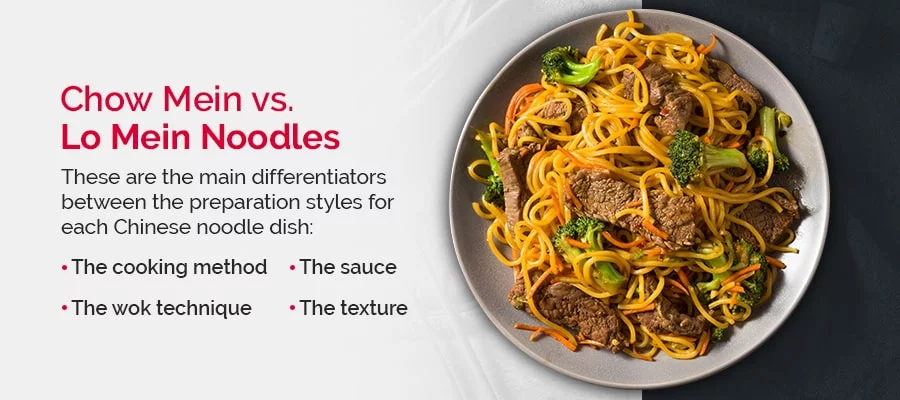What Is Lo Mein?
Lo mein is essentially just tossed or mixed noodles. Vegetables and some type of protein, such as chicken, beef, pork, seafood, or tofu, are typically found in lo mein dishes. Lo mein is essentially a dry take on a classic noodle soup. The chef coats the noodle dish with a flavorful sauce to give it the appearance of soup.
Like ramen, udon, and soba noodles, lo mein is made with fully cooked noodles that have been boiled and drained. After being cooked and combined with different veggies and proteins in a wok, the cooked noodles are added. The mixture is then mixed with the lo mein sauce. After the noodles are barely heated through, all the ingredients are gently combined. To finish the dish, you can now pour some additional sauce over the wok.
If you’re not sure if you’re eating lo mein, try to notice these indicators:
- Lo mein sauce is liberally applied to the entire dish to give it a robust, mouthwatering flavor.
- The noodles are not greasy.
- The dish consists mostly of vegetables and protein that have been combined with noodles and sauce.

Chow Mein vs. Lo Mein: Which Is Better?
The most important consideration when deciding which Chinese noodle dish is superior is personal preference. Some noodle lovers love a big bowl of steaming, sauce-soaked lo mein, while others prefer the crunch of dried egg noodles expertly stir-fried into a tasty chow mein dish.
The texture of your noodles will frequently depend on the other ingredients. Think about combining tougher ingredients like carrots, broccoli, celery, and snow peas with your lo mein dishes, and pairing crispy chow mein noodles with softer ingredients like cooked mushrooms, juicy tomatoes, and bean sprouts.

How to Make Lo Mein
While it uses a slightly different cooking method, lo mein has all the same advantages as chow mein, including versatility, a straightforward sauce, quick and simple cooking, and hidden veggies. For lo mein, noodles are not fried. Rather, thoroughly cooked egg noodles are combined with protein and stir-fried veggies. Additionally, lo mein has a ton of sauce on it to coat the plump, soft noodles.
The ingredients for the lo mein noodles you’ll need to have on hand are listed below before we get into the specifics of cooking this tasty dish:
- Noodles: For the best results, use fresh egg noodles. You can make your lo mein with almost any other kind of long noodle if you’re in a hurry.
- Vegetables: Heartier vegetables like broccoli, bell peppers, sliced zucchini, and carrots are often used in lo mein. For an additional taste boost, you can also add some chopped onion, green onion, and garlic.
- Protein: Nearly any protein goes well with lo mein. Lo mein typically contains tofu, shrimp, turkey, beef, or pork.
- Ingredients for the sauce: Sesame oil, light and dark soy sauces, ginger and garlic, oyster sauce, and a small amount of sugar are the main ingredients of lo mein sauce. Add some red pepper flakes to your noodles if you like them a little spicy.
To create the ideal lo mein, put your ingredients in order and then follow these instructions:
- Boil and drain the egg noodles.
- To make your Lo Mein Sauce, whisk together all the ingredients.
- Add the protein and vegetables to a hot wok or heavy-based skillet and stir-fry. To further season the vegetables and protein while they’re cooking, stir in a small amount of the lo mein sauce. Just cook the vegetables until the outside is lightly browned and the center is still slightly raw. If the vegetables are overcooked, water will seep out and dilute the flavor of the sauce.
- Add the noodles and sauce to the wok.
- Toss the noodles with the sauce and other ingredients using two wooden spoons. Stir frequently and quickly to prevent the noodles from getting too soft, watery, or overdone.
- As soon as the noodles are coated, remove from the wok, plate, and enjoy!
The sauce is what sets apart any lo mein dish, so make sure you take your time and get it just right. Light soy sauce adds extra flavor and saltiness to the dish without discoloring the noodles, while dark soy sauce gives the lo mein color and a bolder taste. Use Tamari, which employs more soy protein to produce a richer, more nuanced flavor, for a stronger, more savory flavor.
Compared to chow mein, this dish will have far more sauce because the sauce is the main ingredient. By soaking up the sauce, the thick and chewy fresh egg noodles perfectly complement the lo mein sauce. These plump, soft noodles are perfect for lo mein because they can be wrapped around chopsticks.

Interested in making a delicious lo mein dish? Try one of these recipes:
- Dan Dan noodles: This recipe, which includes Sichuan peppercorns and chili oil, is ideal if you’re looking for a dish with some heat. Another way to enhance the flavor of your lo mein is to add a small amount of Chinese cooking wine to the sauce.
- Lo mein noodles typically contain chicken as the main meat. Stir-fried chicken can be added to your lo mein to give it a little extra protein boost. This is a traditional Chinese takeout dish. To enhance the flavors of the dish, cook the chicken in the lo mein sauce.
- Szechuan shrimp and asparagus over linguine: This dish will definitely satiate your adventurous palate if you’re the kind of person who enjoys thinking beyond the box. The use of linguine gives this lo mein-style recipe a distinctive texture and a burst of flavor from the addition of a little San-J Szechuan Sauce.
